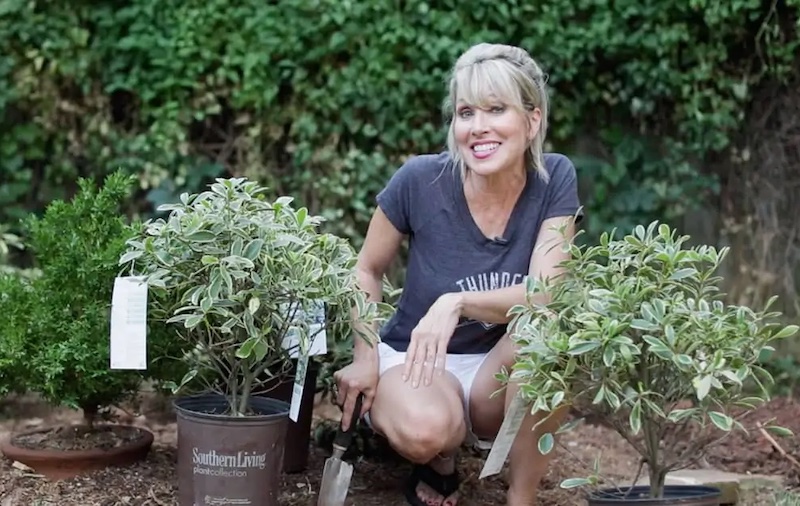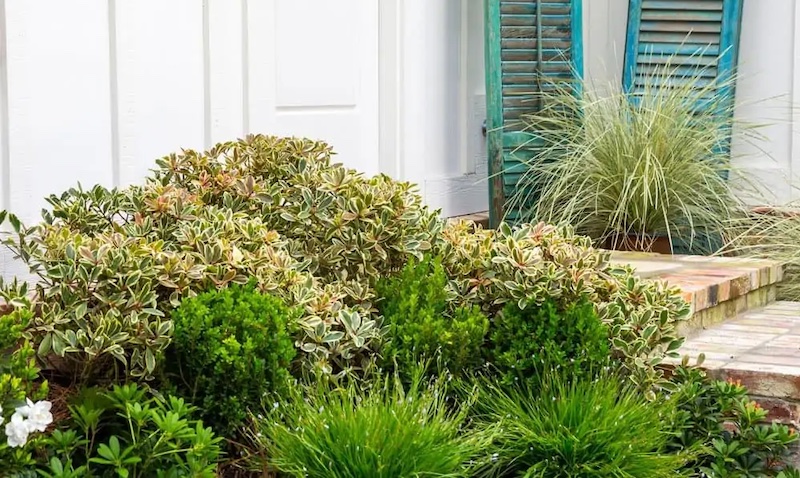Cleyera shrubs, Ternstroemia gymnanthera, are extremely low maintenance, long lived, and virtually pest- and disease-free. The four seasons of interest and evergreen foliage make cleyera valuable as “the bones” of a good garden design in the warmer western and southern gardening zones. Planting these shrubs in the proper location is key to growing thriving plants that remain robust from one season to the next.

What You Need To Plant Cleyera
- Location with well-draining soil
- Shovel or narrow border spade
- Finely shredded organic material (leaves, arborist chips, pine needles) to use as mulch
- Compost or well-decomposed manure to lighten heavy clay soil
- Water source
- Hand pruners
Where to Plant Cleyera
Cleyera requires well-draining soil with an acidic pH between 5.0-6.5. Heavy clay soils will need to be amended with compost to lighten them and improve any drainage issues. Adding sand to lighten soil is no longer a recommendation. The small particles of clay can mix with the larger particles of sand, forming a dense concrete-like texture when the soil dries in the summer. Adding 2-3 inches of compost to the top layer of soil will change the texture of the clay over time, resulting in soil that drains better.
Cleyera tolerates a very large range of sun conditions and can even grow well in full shade. Providing a shaded spot in the afternoon will give cleyera protection from the heat in the hottest growing zones. Shrubs planted in shadier locations will grow slower and need far less pruning to keep their shape than those planted in part to full sun. Always plant the root ball even with the soil line.
Cleyera Spacing
Cleyera average 10-12 feet in height and width, although there are larger and smaller varieties. Spacing the shrubs around 5 feet apart, center on center, will create a dense hedge quite fast. Planting Cleyera at a wider distance for specimens or focal points in the garden is recommended. The mature width will give you a clue to the correct spacing. If the shrub will be 8 feet wide at maturity, space plants so that they are 8 feet away from the center of adjacent plants. There is no danger of cleyera damaging the foundation of buildings or sidewalks. The dense fibrous roots are not aggressive and remain relatively shallow in the soil.

Steps To Plant Cleyera
Step 1 - Choose a location with well-draining soil that is far from the roots of large trees or other shrubs. Even though cleyera is great for understory planting, they do need a space for their roots to spread without competing with other plants for moisture and nutrients.
Step 2 - Amend the soil with 2-3 inches of compost or well-decomposed manure. Spread the material over the area to be planted without digging it in. Digging the hole and planting is all of the mixing in the compost needs.
Step 3 - Dig a hole twice as wide and the same depth as the rootball.
Step 4 - Gently remove the rootball from the pot. Tease apart any roots that are root bound or circling tightly.
Step 5 - Place the top of the rootball at the same depth as the soil line, ensuring that the root collar is just above the soil. Gently backfill the soil into the hole and tamp it down to get rid of any air pockets near the rootball.
Step 6 - Water the shrub in well, making sure to saturate the root zone and surrounding soil.
Step 7 - After the water has soaked in the ground, mulch with 3-4 inches of organic material around the root zone, staying away from the base of the shrub.
Step 8 - Prune out any leaves or stems that were damaged during transplanting.
When to Plant Cleyera
In the warmer USDA growing zones, planting shrubs and trees is best done during fall and winter as long as the ground is pliable enough for digging. Cleyera is semi-dormant during the winter and will establish the best if planted before mid-November. Planting in the spring may be successful if cleyera is kept very well watered during the whole first season. Cleyera purchased in the summer during the hottest weather will survive fine in a pot until the cooler weather of fall arrives. Potted shrubs will need to be checked for moisture levels every day and placed in a shady and sheltered location until planting time.
Transplanting Cleyera
Cleyera is not a good candidate for dividing but can be propagated easily from cuttings taken in the summer. Softwood cuttings taken in the early summer are the easiest to root and grow on. Make sure to only take cuttings from stems that are not blooming. Grow the cuttings in a sheltered location until they begin to sprout new leaves and growth. Cleyera is easily moved from one location to another while still small. Transplanting should be done in the fall while the soil is still relatively warm and moist. Moving larger shrubs may require the use of heavy machinery, but is often successful.
 |
Author Robbin Small - Published 4-25-2023 |
